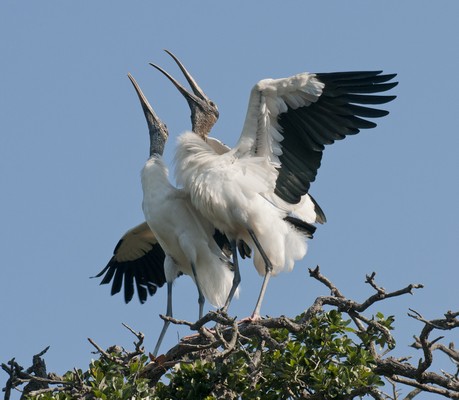
21 Dec Proposed Wood Stork Reclassification

Photo by Ardith Bondi
The St. Augustine Alligator Farm is a proud participant of the Wood Stork Monitoring and Research Working Group. This is directly from the U.S. Fish and Wildlife Service’s Virtual News Room:
Wood storks in the Southeastern United States no longer face imminent danger of extinction
The U.S. Fish and Wildlife Service is proposing to upgrade the status of the U. S. breeding population of wood storks from Endangered to Threatened under the Endangered Species Act (ESA). The proposal follows a comprehensive review, conducted by Service biologists, of the best available scientific and commercial information about the species’ status.
“The proposed reclassification of the wood stork demonstrates that the Endangered Species Act works,” said Dan Ashe, Director for the U.S. Fish and Wildlife Service. “This is a good day for the wood stork, and a good day for conservation. Thanks to great efforts from our conservation partners, the species is making real progress toward recovery.”
The wood stork is the only true species of stork nesting in the United States. Since its original ESA listing as endangered in 1984 the U.S. breeding population has shown substantial improvement in the numbers of nesting pairs as a whole and the expansion of its breeding range. The three-year averages during the past 10 years (2001 – 2010) range from 7,086 to 8,996 nesting pairs, all above the 6,000 nesting pair benchmark average established for reclassifying the species as Threatened, but well below the five-year average of 10,000 nesting pairs needed for delisting.
“Although some habitat loss continues, current population data clearly indicate that the wood stork is benefiting from the work of private landowners and several strong partnership efforts,” said Cindy Dohner, the Service’s Southeast Regional Director. “The wood stork is expanding its breeding range using a wide variety of wetlands to forage, roost, and breed, including man-made and restored wetlands.”
The proposed reclassification would not change any conservation or protection measures for the wood stork under the ESA. Rather it would recognize the stork’s ongoing recovery and the positive impact that collaborative conservation efforts over the last two decades have had on breeding populations. With a continuing trend, the species could become suitable for de-listing from the ESA. Therefore, addressing the threats associated with habitat loss, including the protection of natural wetlands through partnerships and the focused management of public lands, remains a conservation priority for the Service.
When the Service originally listed the Southeastern U.S. portion of the population, the wood stork’s range included Florida, Georgia, South Carolina, and Alabama and breeding was primarily in central and south Florida. Historically the Florida Everglades and the Big Cypress National Preserve once supported large breeding colonies. Today its range includes portions of North Carolina and Mississippi with significant nesting in Florida, Georgia, and South Carolina. Biologists believe man-made changes in the Everglades and Big Cypress ecosystems have contributed to the bird’s expanded breeding range.
The Natural Resources Conservation Service (NRCS) Wetlands Reserve Program has restored over 200,000 acres of wetlands in Florida and more than 115,000 acres in Alabama, Georgia, and South Carolina during the past 18 years. Thousands of acres of wetlands are also being protected on private lands to assist in habitat and wildlife protection through restoration in conjunction with establishing conservation easements. Wetland losses are being avoided, minimized, and mitigated through project consultations and the regulatory process.
“The wood stork has shown a fascinating ability to respond to changes in hydrology by broadening its breeding range beyond central Florida, the Everglades, and Big Cypress ecosystems,” said Dave Hankla, Field Supervisor for the Service’s North Florida Ecological Services Office in Jacksonville. “However, this does not reduce the importance restoration of the stork’s historical breeding area has for recovery. Nor does it diminish the significant role South Florida’s ecosystems play for wood storks and other wildlife.”
Large-scale restoration projects such as the Comprehensive Everglades Restoration Program (CERP), Kissimmee River Restoration Project, and St. Johns River Headwaters Restoration Project are significant conservation efforts that continue to greatly benefit wood stork recovery. Florida nesting pairs totaled more than 5,000 in 2011. Here are some examples from other states:
- Alabama: Ongoing wetlands restoration projects, such as those undertaken in several U.S. Fish and Wildlife Service National Wildlife Refuges (Eufaula and Choctaw NWRs) and the State of Alabama’s Wildlife Management Areas (Demopolis WMA and Upper Delta WMA), are providing excellent foraging habitat for post-breeding wood storks dispersing following the nesting season.
- Georgia: Through public and private partnerships with NRCS, nearly 20,000 acres of key wetlands are restored and/or being managed for the benefit of a wide variety of wildlife, including nesting wood storks. In 2011, Georgia had 2,160 nesting pairs.
- Mississippi: Along the eastern part of the state, wetlands associated with federal lands (including the Sam D. Hamilton Noxubee National Wildlife Refuge, with its moist-soil waterfowl management, and the Tennessee-Tombigbee Waterway) attract feeding wood storks, as well as other long-legged wading birds and wildlife.
- North Carolina: Wood storks were first observed nesting in North Carolina in 2005, with the two known colonies occurring on private lands. While the wood storks nest on private lands, the birds are routinely observed foraging on a broad range of federal and state protected wetlands throughout southeastern North Carolina. In 2011 the nesting survey found 96 nesting pairs bringing the State’s three-year average to 141 pairs.
- South Carolina: Public and private partnerships, such as the Ashepoo, Combahee, and Edisto (ACE) Basin Task Force protect and manage coastal estuaries and are contributing to a growing number of wood stork nesting colonies. In 2011, South Carolina’s three-year average was 2,031 nesting pairs.
